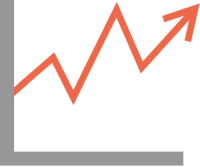Many people invest to secure retirement income, others do it for a hobby, however you invest, you should have goals and a purpose for your capital.
If you don’t accumulate savings, you could find yourself coming up short financially and working well into your twilight years.
While savings accounts are the preferred option for many, the interest your money accrues in these accounts is often less than a tenth of a percent. While reliable and low risk, money market accounts and CDs provide bare bones growth at best, topping out at around 2% interest each year.
Many people have taken investing in to their own hands, seeking higher returns.
Why invest?
Investing can provide a financial cushion for your future. By investing in stocks, bonds, startups, and more, you can help your savings grow, retire comfortably, and even preserve your spending power in times of future inflation.
Simply put, investing can keep you financially covered in ways a savings account often cannot. Investing can offer many multiples of your original investment, netting you enough to keep you financially secure. Putting your money in a savings account would net you .01% interest, but investing in a conservative index fund could net you average yearly gains of 9.8%. Other investments could even yield much higher than that. But unlike a traditional savings account, investments may not be liquid and are subject to higher market risk and volatility.
There are numerous ways to invest, and while the payoff can be big, it is not risk free. Unlike savings accounts, investments in stocks and startups do not guarantee returns on your initial investment. With most investments you make, you’re risking everything you put in for a greater reward.
Yet, that reward could make the difference between retiring early and never retiring at all. This is why investing is one of the smartest and most consistent ways to grow your money in the long term.
When should you invest?

There’s no correct time to invest your money, whether it’s in the stock market, startups, or elsewhere. The general idea is to buy low and sell high, but pinpointing a stock or bond’s lowest lows and highest highs is hardly an exact science. Though a market could be at a 10-year high or in the midst of a recession, there’s never a bad time to invest if you’re investing for the long haul. Best of all, the earlier you invest, the higher potential you have for returns.
Learn more about how to start investing.
Let’s say you’re 18 and inherited some money, or maybe you’ve put some away from your part-time job. If you put $5,000 into an investment account that sees an average return rate of 7% and keep contributing around $300 dollars annually, that $5K could be worth over $50K when you’re 43. Those are some awesome (and rather conservative) returns! Just be aware, they aren’t guaranteed and are subject to market risk and your own investment allocations.
It’s never too early to consider investing, but most people start seriously considering investing around the age of 22. Maybe they’ve recently graduated from college, or perhaps they’ve held down a job for a couple years and are looking to maximize their future cash flow. Around this age, if you put money into an investment account managed by a financial advisor, contribute to a 401(k) or IRA plan, or trade on the stock market, you’re making a smart decision by investing early.
It’s also never too late to start investing. Even if you are over 65 years old, there are still plenty of opportunities, yet some different considerations. It’s best practice for seniors to prioritize investments that come with a more immediate payout, such as short term stocks, mutual funds, bonds, and perhaps angel investing. It’s also useful to consider the assets you currently have, including real estate, 401K accounts, and other commodities you may have accrued to date.
In the end, it’s never too late or too early to start investing. The best time to start investing is now, and the worst time to invest is never.
So, how much can you earn?
When it comes to investing earnings aren’t guaranteed, so there’s no exact amount you can earn. You could even lose money.

Yet with almost all investments, you have limited risk — your initial investment. Similarly, there is unlimited upside — potential for gains. This means that you could put in $100 and make over $800,000 (as early Apple investors did), make $20 (if your investment increases by 20%), or lose $100 (if your investment is eventually worth nothing). As you can probably tell, the possibilities are endless. To calculate potential returns, you can go the old-fashioned route and use a pen and paper to calculate average gains, average losses, and so on. Be sure to calculate from the start your investment goal and how long it might take to achieve your desired returns.
What do you invest in?
There aren’t best ways to invest or even right ways to invest. There are, however, multiple investment vehicles that will let you invest in stocks, bonds, securities, and other investment types. Each investment vehicle comes with its own pros and cons.
Investing in stocks 
So, you’ve decided you want to start investing in stock. Congratulations! The first step is to open an investment account. For those interested in doing it themselves, this is usually an account with a brokerage, which throws you into the deep end but is ultimately one of the better ways to learn how to invest your money. For those seeking professional advice, your financial advisor can help open different kinds of accounts for you.
A brokerage account offers you the quickest and least expensive way to buy stocks, funds and other investments. You fund your account by adding your bank account (as you cannot and should not invest in the stock market using a credit card.) You should follow your budget and the investment goals you originally outlined to determine how much you want to initially invest. Then, you can watch that investment grow (or fall, depending on the stock and market conditions).
If you are looking to get a little more advanced with your investments and go beyond a standard brokerage account, it might be worth targeting individual stocks. These are equal to the value of a share in a specific company. These often make the most money, but they are also a higher risk, as the chances of a company becoming the next big industry titan are slim. If you do decide to purchase individual stocks, it’s smart to diversify and purchase stocks in multiple companies; this helps decrease your overall risk.
Mutual funds 
Mutual funds work like a group purchase. They allow you to buy into a collection of stocks rather than going all-in on one single stock. Mutual funds are often chosen and managed by a mutual fund manager, but they can also be tracked by a stock market index.
Investing in mutual funds allows you to gain instant diversification by letting you hold many stocks, bonds, or other investments with a single purchase. They do, however, typically come with initial fees. These fees are usually 1% of your portfolio, regardless of gains and losses. Fees may increase if you are working with an external firm to manage your portfolio. Mutual funds may also require a minimum starting balance or minimum investment.
Learn more about investing in mutual funds.
Bonds 
Bonds are usually thought of as fixed-income assets and are great first-time investments. Investors will make money when the company selling the bond pays interest on a loan over a set number of years. Bonds gain interest and, over time, will at least return your initial investment. They are less risky than other options, but have the potential for a lower overall payout and can take years—even decades—to appreciate in value.
Retirement accounts 
For most people, investing begins with their retirement accounts. These are often baked into your paycheck or employee benefits, and can be a great way to invest as you plan for the long term. There are a few different types of retirement accounts available:
401(k): Most people have heard of a 401(k), as these are usually a part of your employment package. Typically, your employer matches a portion of what you put into the account. This money can be rolled over and grows as you change jobs and move throughout your career (so long as your employer offers them). You can also create your own 401(k) plan if you are self-employed or a business owner.
Traditional IRA: IRA stands for individual retirement account. Unlike 401(k)s, IRAs are opened by individuals and can come with additional tax benefits. Individuals can deduct contributions into the account from their federal and state taxes, and pay taxes on any withdrawals later.
Roth IRA: Similar to a standard IRA, a Roth IRA comes with great tax advantages. The primary difference is with timing; with a Roth IRA, you pay taxes on contributions you put into the account and then redeem tax-free withdrawals later.
Rollover IRA: A rollover IRA is an account that allows you to move money from your employer-sponsored retirement account—in most cases your 401(k)—into an IRA account. With a rollover account, you can keep the tax-deferred status of your retirement funds, without paying current taxes or early withdrawal fees.
Physical commodities 
Physical commodities are objects you can actually see and touch, like grain, oil, and metals. Physical commodities are a great way to diversify your portfolio outside of the stocks and bonds market.
Gold is a great example of a classic physical commodity – you can own it, sell it when the market is good, or just keep it in your back pocket. That being said, the supply and demand of the market for a particular commodity can fluctuate and impact your overall return on the investment.
Real estate 
Real estate is a traditional long-term investment. For most, real estate is a good way to have a steady and fixed investment that appreciates over time. As with any long-term investments though, real estate is subject to the rise and fall of the market. Real estate investments could also incur added costs like maintenance, repairs, and other property-related surprises that might mean sinking in thousands of dollars more.
Learn more about investing in real estate.
Startups 
We’ve all heard the stories of investors winning big by investing in startups. Who doesn’t wish they’d invested in Apple or Google before they exploded? Most startup investing starts with angel investors, or people who bank on the company to increase in value over time. You can also invest in startups on crowdfunding platforms like Republic, which is markedly different than investing with venture capital firms.
Investing in startups is a high-risk, high-reward investment. Unfortunately, not all startups succeed — fewer than one percent turn out to be successful — so it’s smart to do your research on the company, the founder and team, and to diversify as much as possible.
Crowdfunding 
When it comes to investment crowdfunding, campaigns on sites like Republic allow companies to raise capital from individuals. This gives people the opportunity to invest in products and companies they believe in and at an early stage, with the promise of a return on their investment during an exit event. This can also lead to potentially huge payoffs later, if that company is successful and either goes public or gets acquired by another company but is also subject to substantial risk as early stage startups are unproven and high failure rates historically.
Learn more about what is crowdfunding and how does it work.
Cryptocurrency 
Cryptocurrency has become a hot topic over the last few years, in part because of the incredible highs and lows of people who’ve invested. People can earn cryptocurrencies by doing bounties or taking on gigs for which they are rewarded tokens or other assets. They can also purchase currencies on the blockchain, or use energy-consuming mining rigs to create new tokens on the. There are multiple currencies out there, so it’s worth researching which currencies you want in your wallet. As with other investments, while the payout can be extraordinary, don’t invest more than you can afford to lose; cryptocurrencies are notoriously volatile, which means their value can decrease just as fast as is increased.
Here you can learn more about Bitcoin and other cryptocurrencies investing.
Investing for the first time
Investing — in whatever form — is always a smart idea. While there’s no correct way to start investing, you could begin by putting money aside in an IRA or 401(k) account. This is an easy way to invest with great tax incentives, and is geared entirely towards saving for retirement. You should also use an investment calculator to figure out your budget and goals based on your debt, your income, and other financial factors.
If you are looking for a short-term return, or a payout in less than three years, you might want to look into stocks or places where you can play the market and have a quick, high return. These investment vehicles are more liquid — meaning they can be liquidated from security to cash with relative ease — but also carry more risks than retirement accounts.
If you are interested in long term returns, crowdfunding, angel investing, and real estate all offer great ways to invest money now for a bigger payout later. There’s also more risk to this, but again, with great risk comes great reward. You can also invest in a stock and hold it for a prolonged period of time — perhaps even for decades.
Risk vs reward

We’ve talked a lot about risk and reward. Startups and stocks, which are more volatile than other investments, often have the highest chance of making major cash, but they also come with the risk of potentially losing your entire investment. It’s OK to take risks, but you should always diversify your investments. This means placing small amounts in multiple investments versus large amounts in only a few investments. You should also always invest assuming there’s a chance you will not get back your initial investment.
Safer investments are generally considered bonds, mutual funds, and retirement accounts. They are safe because you put money into them and wait for the value to grow over a long period of time, while spreading your money across multiple avenues. These typically come with a smaller payout, but they can be great to bank on for the long term.
Should you do things yourself or get help with your investments?
Only you can decide the best way to manage your investments.. The cost of paying a professional to manage your assets can seem expensive and unnecessary. Most people can manage their portfolio by themselves, but it’s something that requires some introspection; you should be honest about whether you have the knowledge and experience needed to make the most of your investments.
For many, paying a fee upfront to hire a trusted professional is totally worth it; the expertise of a professional may mean bigger returns. You could also consult a “robo-advisor” service, or an AI-based personal advisor or app that uses algorithms to help people invest.
Whichever approach you choose, it’s always worth considering your personal investment style and level of expertise. You should also always consult your tax professional or accountant to assess your unique financial situation and how capital gains taxes from investments could impact your taxes.
Where to go from here?
If you’re looking to start investing, Republic offers individuals a number of resources and opportunities to invest in vetted private startups. These startups are long-term investments, and though they carry many of the risks stated above, the rewards associated with them can outweigh those of individual stocks. The startups on our platform are highly selective — less than 3% of companies pass through our due diligence and investment committee. With Republic, you can invest as little as $10 to help you build a diversified portfolio of startups.
This educational article is provided by Republic to help its users understand this area of the market, it should not be construed as investment advice as it is impersonal, disinterested and was produced by Republic for Republic’s users, without remuneration received or expected.


 Oops! We couldn’t find any results...
Oops! We couldn’t find any results...








8 comments